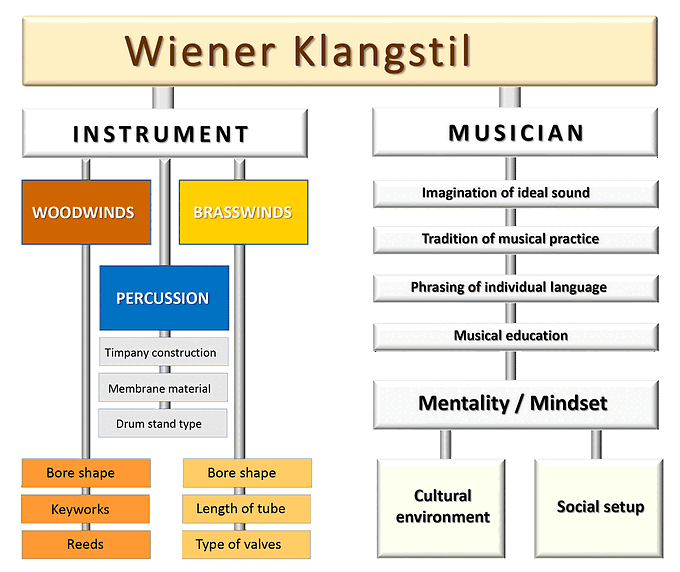Wiener Klangstil (Viennese Music Tradition)
Definition of the Viennese Music Tradition
The term "Wiener Klangstil" refers to the particular way in which Viennese and – to an extent – Austrian orchestras interpret orchestral and chamber works, preferring a performance style and tonal qualities markedly different from international practice. (Widholm Gregor: "Wiener Klangstil" in: R. Flotzinger (ed.), Österreichisches Musiklexikon, vol. 5. Verlag der Österr. Akademie d. Wissenschaften. pp. 2653–2654. ISBN 3-7001-3042-2.)
Sound differences of orchestral interpretation have been known throughout the history of instrumental music. In spite of the relatively uniform notation of the scores used, the way in which orchestral music was played in the various musical capitals of Europe up to the 20th century differed considerably. This is hardly surprising since the interpretation was done on different regional instruments and was subject to the given tradition of musical practice, the intellectual climate and the social setup in the largely closed cultural environments of that time. The opportunity for direct but subjective comparison was given only to widely traveled musicians and performers as well as to a small elite audience.
With the use of mass media in the 20th century the situation changed radically: international standards for orchestral sound have developed since. Nowadays in an "international concert" there are only a few orchestras which can be easily recognized. One of these is the "Vienna Philharmonic Orchestra", which is said to be the incarnation of the "Wiener Klangstil". It's no wonder that music lovers all over the world identify the "Vienna Philharmonic" with "Wiener Klangstil".
For most people -even musicians- "Wiener Klangstil" is a very vague and hazy term. The contributions on this website will attempt to help you understand some of its fundamental principles and serve as a guide to get closer to the roots of the Viennese sound. But you should be aware that the "Wiener Klangstil" is a very complex phenomenon, too extensive to be discussed here in detail and requiring much more space and time than is here possible.
The table below shows that there are two main components which contribute to that particular way of interpretation of music in Vienna, the so called "Wiener Klangstil":
- the type of instruments used
- the musician with its artistic setup
The ratio of contribution of these two components can differ considerably and depends on the instrument we look at. If we look, for example, at the horns, we can state that the artistic style of playing is mainly determined by the acoustic characteristic of that instrument, whereas in the case of the strings the contribution of the component "musician" is nearly 100%.

Publications
Widholm, Gregor (2013)
"Gustav Mahler und der Wiener Klangstil heute,".
Widholm, Gregor (2002)
"Wiener Spezialitäten Besonderheiten der Wiener Orchesterinstrumente,"
Das Orchester 50(9), 25 - 32.
Widholm, Gregor (2002)
"Viennese Sound: Traditional belief or actual reality?,"
in Musica E Crisi Sonora (Michael Stüve, Firenze) 38, p. 101-110.
Widholm, Gregor (1999)
"Wiener Klangstil - Was ist das?,"
in Hornpostille (Erste Gesamttiroler Horngesellschaft, Zirl, Österreich) 3, p. 18-22
Sonneck, Gerald and Widholm, Gregor (1995)
"On the sound of horns and oboes — typical properties of Viennese orchestras,"
in Speech - Music - Hearing, Proceedings of the 32nd Czech Conference on Acoustics, Prag 1995, edited by Alois Melka and Jan Stepánek and Zdenek Otcenásek (Prag) p. 139-142.
Widholm, Gregor (1992)
"Der Einfluß des Instrumentariums auf den Klang der Wiener Philharmoniker, aufgezeigt am Beispiel des Wiener Horns,"
in Klang und Komponist. Symposium der Wiener Philharmoniker (Kongressbericht, Wien 1990), edited by Otto Biba and Wolfgang Schuster (Tutzing) p. 343-366.
Widholm, Gregor (1990)
"The Sound-Characteristics of the Vienna Philharmonic Orchestra Investigated with Digital Measuring Methods,"
(AUDIO ENGINEERING SOCIETY, New York).
Widholm, Gregor and Sonneck, Gerald (1987)
"Dokumentation und Analyse der Besonderheiten des Wiener Orchesterklanges auf naturwissenschaftlicher Ebene — am Beispiel Horn. [Endbericht des Projektes P 5467 (FWF)],"
p. 160.
Widholm, Gregor (1983)
"Untersuchungen zum Wiener Klangstil,"
(Czechosl. Scient. & Techn. Society, Hradec Králové) p. 107-112.
Widholm, Gregor (1983)
"Untersuchungen zum Wiener Klangstil,"
Österreichische Musikzeitschrift(1), 18-27.
Widholm, Gregor (1981)
"Dokumentation des Wiener Klangstils,"
(Wien) p. 52-54.